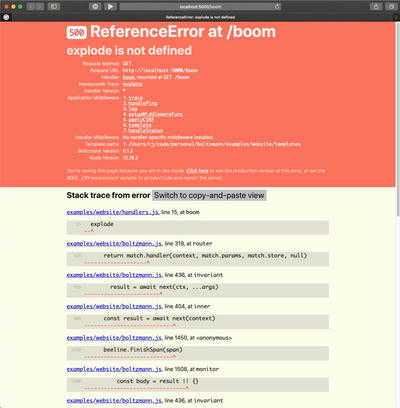Boltzmann's defaults are good for building API servers, but it can be configured with features that give you a jumpstart with building websites. Specifically, you can build services that respond to route handlers with templated text/html responses as well as JSON responses.
To scaffold a service with all website-focused features, pass the --website option.
This invocation gives you a simple website scaffold:
> boltzmann-cli --website --silent my-website
Boltzmann at 0.1.2 with csrf, githubci, jwt, ping, status, templates
Run the server with node my-website/boltzmann.js. Point your browser to
http://localhost:5000/hello/world to see the index template being rendered.
§ Development mode vs production mode
Boltzmann changes its behavior if it is running in development mode. It makes
this decision using are-we-dev.
Not setting anything in process.env.NODE_ENV counts as being in development mode.
If you set NODE_ENV to anything that matches staging, test, or prod,
Boltzmann switches out of dev mode.
Logging output is pretty-printed in dev mode, and newline-delimited JSON otherwise. CORS headers are more relaxed in dev mode, and Boltzmann will reveal more information about errors. In particular, it'll render an informative error page when the templating feature is available; read on for details.
In dev mode, Boltzmann provides a static file server for convenience.
§ Cookies
Cookie handling is always enabled in Boltzmann. The context object passed to each route handler has functions for getting and setting cookies. The underlying implementation of cookie parsing is from jshttp/cookie.
The functions for examining cookies are:
context.cookie.get(name): Get the named cookie; returns an object.context.cookie.set(name, value): Set the named cookie. Sends the passed value to jshttp'scookie.serialize().context.cookie.delete(name): Un-sets the named cookie.
See the full cookie documentation for more detail.
§ CSRF protection
You can toggle the cross-site request forgery protection (CSRF) feature on its own by
passing --csrf=[on|off].
Boltzmann uses the double-submit pattern to check that a form submission is valid. It stores a secret in a signed cookie for the user. On requests with HTTP verbs indicating mutation it verifies that a) the cookie signature is good, and that b) the submitted token is valid for that secret.
You can configure the csrf middleware by passing an object with these fields
to boltzmann.middleware.applyCSRF:
cookieSecret: the secret used to sign the cookie; defaults toprocess.env.COOKIE_SECRET; requiredcsrfCookie: the name of the cookie to store the token in; defaults to_csrfparam: a body param to look for the csrf token in; defaults to_csrfheader: a response header to look for the csrf token in; is consulted first if both are used; defaults tocsrf-token
§ Templates
You can toggle the template rendering feature on its own by passing
--templates=[on|off].
Boltzmann's templates feature uses
Nunjucks templates. Template files by
default live in the ./templates directory. Scaffolding with this feature
creates templates directory with an example index.html file for you, along
with a handler that renders it.
To respond from a route with a rendered template, name the template file in the object return by the route handler using a symbol, like this:
return {
[Symbol.for('template')]: 'index.html',
cats: ['Fezzik', 'Mina', 'Oswin' ],
count: 10
}
Everything else in the object is passed to the template renderer as context.
§ Error templates
If your route handler throws an error and the content-type requested was JSON,
Boltzmann responds with JSON errors. If you throw and the content-type requested
was HTML, Boltzmann looks for 4xx.html or 5xx.html template files.
In development mode, Boltzmann renders you a debugging page with as much information as it can gather about the stack. This includes links to source code and to Honeycomb traces if they're available. It will also catch errors in rendering error templates.

Boltzmann only renders this debugging page if it was attempting to render a template for the route experiencing the error.
§ Static asset serving
Boltzmann also has a static file server built-in, which can help you test static
assets like images. This feature is disabled in production, on the assumption
that you will be serving static assets from a CDN. Static assets are in the
static directory by default.
Here's a project layout that requires no additional configuration:
.
├── boltzmann.js
├── handlers.js
├── middleware.js
├── package.json
├── static
│ └── favicon.ico
└── templates
├── 4xx.html
├── 5xx.html
├── base.html
└── index.html